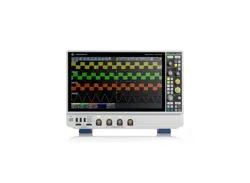Loading ...
Loading ...
Loading ...

Network operation and remote control
R&S
®
MXO 5 Series
425User Manual 1802.3369.02 ─ 02
Bit
No.
Meaning
13
PLLunlock
This bit is set if a phase-locked loop process is unlocked. There are two reasons:
●
external reference is missing or defect
●
hardware defect of internal PLL
14 - For future use.
16.5.3.5 Application of the status reporting system
The purpose of the status reporting system is to monitor the status of one or several
instruments in a test system. In particular, it monitors continuous measurements to
detect errors in the signal. The controller must receive and evaluate the information of
all devices.
The following standard methods are used:
●
Service request: An SRQ is initiated by the instrument.
●
Query of a specific register by commands
●
Query of the error queue
These methods are described in the following sections.
Service request
The instrument can send a service request (SRQ) to the controller. Usually, this service
request initiates an interrupt at the controller, to which the control program can react
appropriately.
An SRQ is initiated if one or several of bits 2, 3, 4, 5 or 7 of the STB are set and
enabled in the SRE. Each of these bits combines the information of a lower-level regis-
ter, the error queue or the output buffer.
The ENABle parts of the status registers can be set such that arbitrary bits in an arbi-
trary status register initiate an SRQ. To use service requests effectively, set all bits to
"1" in the mask registers SRE and ESE.
The SRQ is the only possibility for the instrument to become active on its own. Config-
ure the instrument so that it initiates a service request if errors occur. And ensure that
your program reacts appropriately to service requests.
Query of a register
The STB and ESR registers contain 8 bits, the SCPI registers 16 bits. The contents of
a status register are specified and transferred as a single decimal number. Therefore,
each bit is assigned a weighted value. The decimal number is calculated as the sum of
the weighted values of all bits in the register that are set to 1.
Remote control - status reporting system
Loading ...
Loading ...
Loading ...
